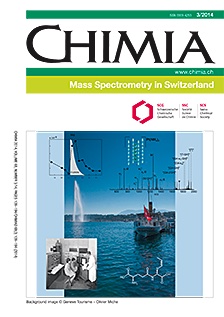Elucidation of Nucleic Acid–Drug Interactions by Tandem Mass Spectrometry
DOI:
https://doi.org/10.2533/chimia.2014.164Keywords:
Cisplatin, Gas-phase dissociation, Higher-order nucleic acids, Nucleic acid-drug interactions, Tandem mass spectrometryAbstract
In continuation of the long tradition of mass spectrometric research at the University of Bern, our group focuses on the characterization of nucleic acids as therapeutic agents and as drug targets. This article provides a short overview of our recent work on platinated single-stranded and higher-order nucleic acids. Nearly three decades ago the development of soft ionization techniques opened a whole new chapter in the mass spectrometric analysis of not only nucleic acids themselves, but also their interactions with potential drug candidates. In contrast to modern next generation sequencing approaches, though, the goal of the tandem mass spectrometric investigation of nucleic acids is by no means the complete sequencing of genetic DNA, but rather the characterization of short therapeutic and regulatory oligonucleotides and the elucidation of nucleic acid–drug interactions. The influence of cisplatin binding on the gas-phase dissociation of nucleic acids was studied by the means of electrospray ionization tandem mass spectrometry. Experiments on native and modified DNA and RNA oligomers confirmed guanine base pairs as the preferred platination site and laid the basis for the formulation of a gas-phase fragmentation mechanism of platinated oligonucleotides. The study was extended to double-stranded DNA and DNA quadruplexes. While duplexes are believed to be the main target of cisplatin in vivo, the recently discovered DNA quadruplexes constitute another promising target for anti-tumor drugs owing to their regulatory functions in the cell cycle.Downloads
Published
2014-03-26
Issue
Section
Scientific Articles
License
Copyright (c) 2014 Swiss Chemical Society

This work is licensed under a Creative Commons Attribution-NonCommercial 4.0 International License.
How to Cite
[1]
Y. Hari, A. Nyakas, S. R. Stucki, S. Schürch, Chimia 2014, 68, 164, DOI: 10.2533/chimia.2014.164.







